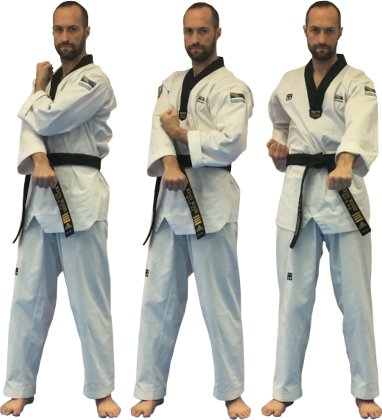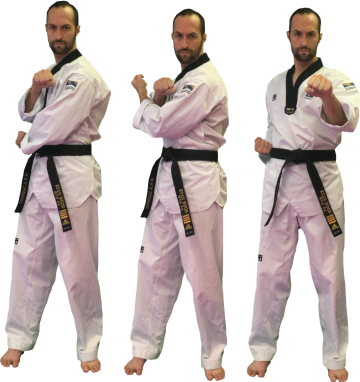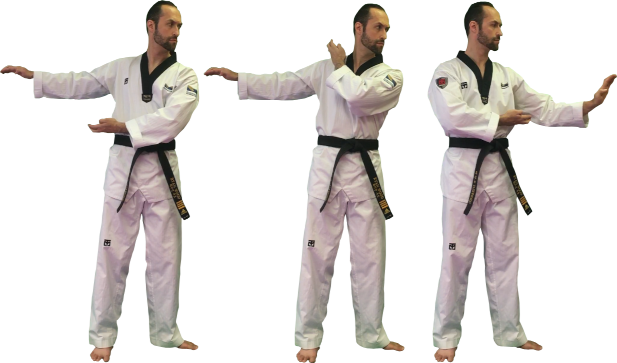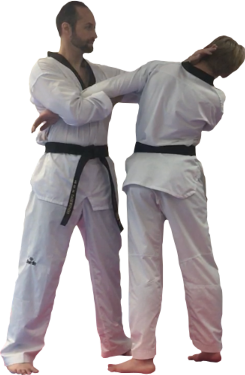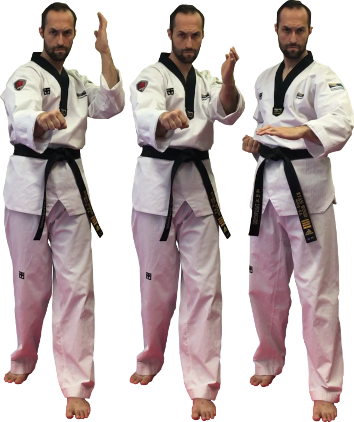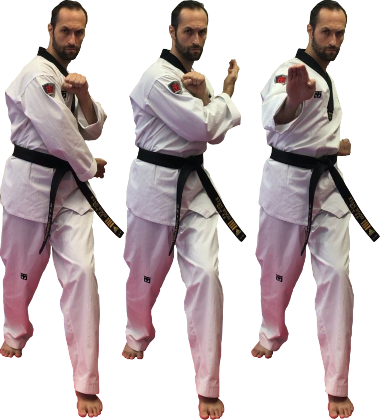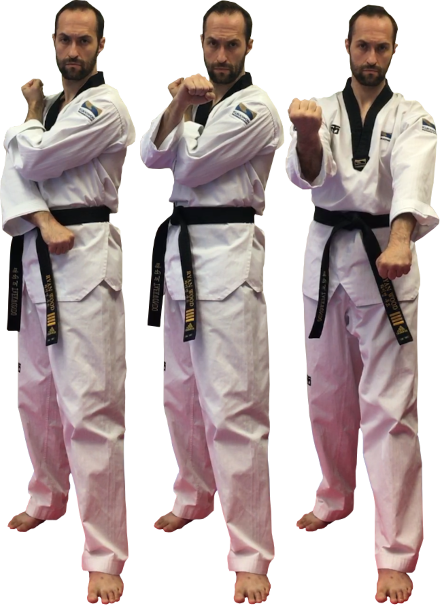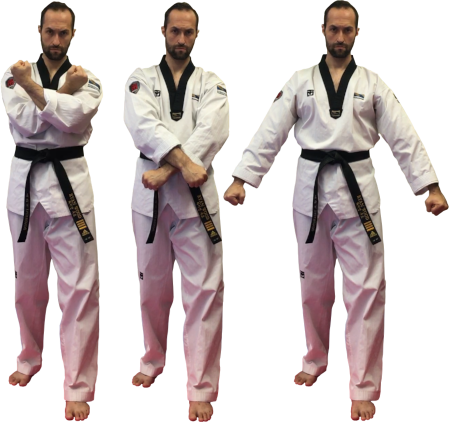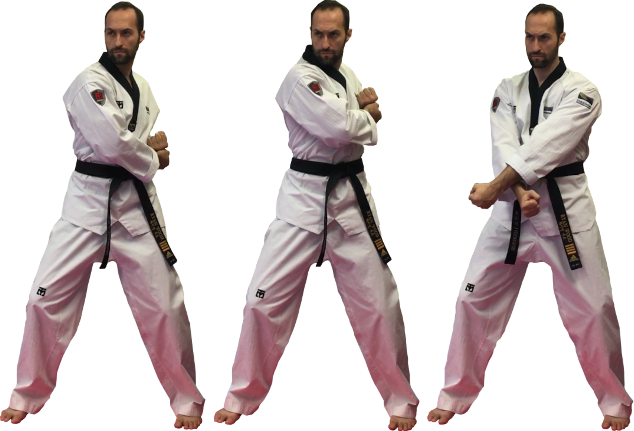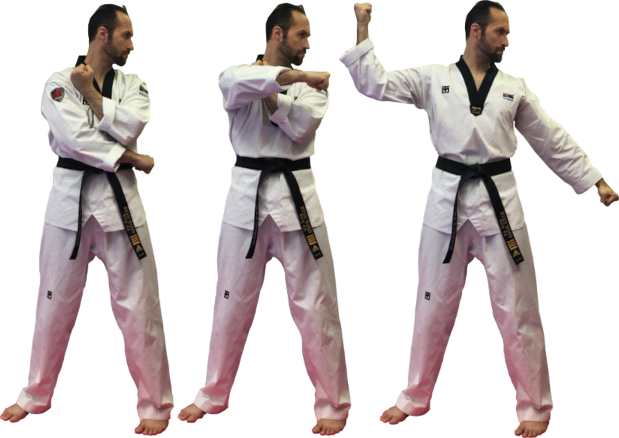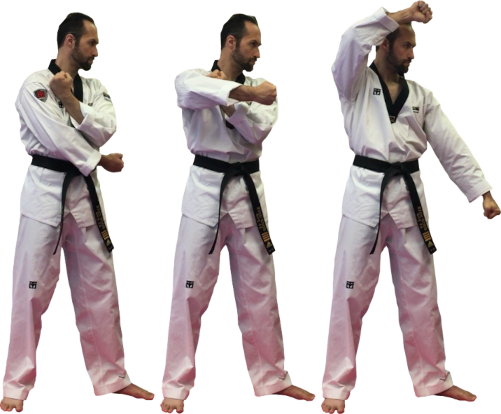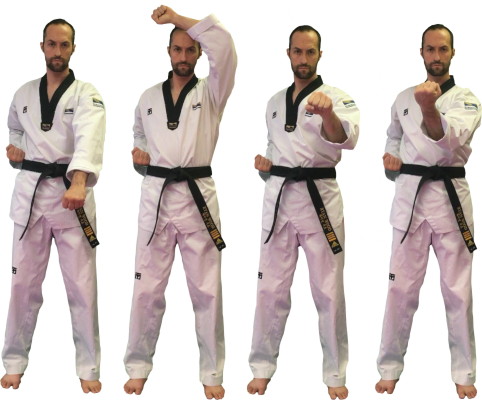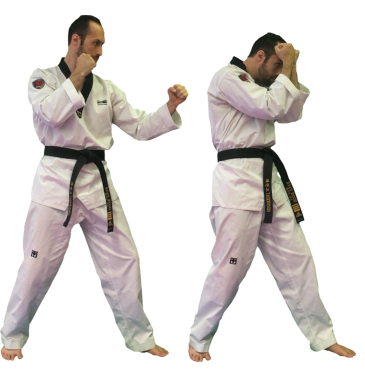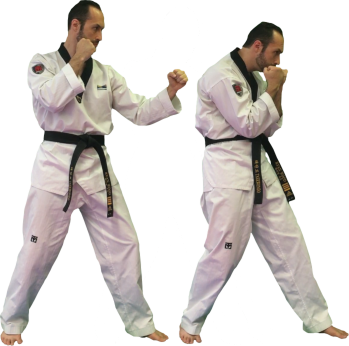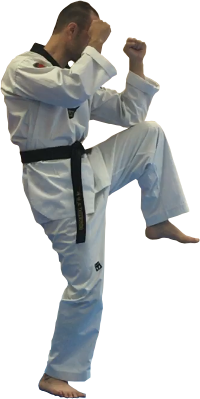Blocking Techniques
Makgi Kisul - 막기 기술
“A block is a lock is a strike is a throw”
- Iain Abernethy
When examining “traditional” martial arts blocks it is important to keep in mind that not every technique is meant to be one’s limb(s) directly intercepting a strike.
Essentially, the realistic options for blocking a strike during consensual violence (martial arts sparring or competition) in the most commonly understood sense can be summarized as seen below.
Four Directions Of Blocking:
Downward Block / Naeryeo Makgi / 내려 막기
Upward Block / Ollyeo Makgi / 올려 막기
Inward Block / An Makgi / 안 막기
Outward Block / Bakkat Makgi / 바깥 막기
Four Types Of Blocking:
Striking Block / Chyeo Makgi / 쳐 막기
Parrying Block / Geodeo Makgi / 걷어 막기
Absorbing Block / Bada Makgi / 받아 막기
Tripping Block / Georeo Makgi / 걸어 막기
Three Levels Of Blocking:
Low Block / Arae Makgi / 아래 막기
Middle Block / Momtong Makgi / 몸통 막기
High Block / Eolgul Makgi / 얼굴 막기
For example you could have a Downward Striking Block, a Downward Parrying Block, a Downward Absorbing Block or a Downward Tripping Block. From here you can add further specificity by indicating the body part primarily being used in defense (Palm Heel, Knife Hand, Inner Forearm, etc).
During consensual violence (martial arts sparring or competition) typically one arm performs the blocking technique while the other remains in a guarding position.
During non-consensual violence (criminal assault) these techniques are of course still required, applicable and realistic but one should account for the often abrupt nature of the situation as well as the close proximity to the assailant when compared to sparring.
In this situation we need to expand our idea of what it means to block to encapsulate the overall ability to impede an attacker from being successful.
A block is a lock is a strike is a throw.
An Important Point About 1st Position:
1st Position → Path → 2nd Position
Each technique has what I call a “1st Position” — where the hands and arms are placed prior to executing the movement. In most cases, this is the actual defensive action being taken (often it amounts to crossing the arms over the face or body) with the “Path” and “2nd Position” being what’s done after the strike or grapple has been blocked/absorbed/parried/etc. by this initial movement.
This is where I see a lot of application (bunae / bunkai) demonstrations go off the rails into make believe — they treat the 2nd Position as being what has dealt with the violent act rather than as what is done afterward.
Pulling Hand
Dang-Gineun Son
당기는 손
“Dahng-Gee-Noon Sohn”
The hand which is placed at the hip or solar plexus during a poomsae style technique. Can also be called 당기 손 Danggi Son.
Its purpose is often misunderstood and/or falsely represented.
When taken as a practical idea, the pulling hand is always meant to have grabbed onto the other person in an attempt to:
disrupt their balance or posture
provide proprioceptive feedback
clear one of their limbs in order to make a path for offensive movements
This hand should never be interpreted as:
a “guard” posture
a method of power generation
a preparatory motion
In Japanese styles of martial art this is referred to as the 引き手 Hiki-Te, which also means Pulling Hand.
"Hiki-Te – pulling hand, the moment you block the opponent's fist, you grab and pull his fist towards you. In doing so, you attack him. The fact that you pull him in towards you means that you are disabling your opponent from using his waza (technique) and making him lose balance. At the same time, the effectiveness of your fist increases; this is most important. It is even more effective if you can pull-in with a twisting motion rather than just pulling."
- Gichin Funakoshi, the Father Of Modern Karate
-
Downward Block / Naeryeo Makgi / 내려 막기
Upward Block / Ollyeo Makgi / 올려 막기
Inward Block / An Makgi / 안 막기
Outward Block / Bakkat Makgi / 바깥 막기
-
Striking Block / Chyeo Makgi / 쳐 막기
Parrying Block / Geodeo Makgi / 걷어 막기
Absorbing Block / Bada Makgi / 받아 막기
Tripping Block / Georeo Makgi / 걸어 막기
-
Low Block / Arae Makgi / 아래 막기
Middle Block / Momtong Makgi / 몸통 막기
High Block / Eolgul Makgi / 얼굴 막기
-
Front Face Block
Eolgul Ap Makgi
얼굴 앞 막기Front Body Block
Momtong Ap Makgi
몸통 앞 막기Side Face Block
Eolgul Yeop Makgi
얼굴 옆 막기Side Body Block
Momtong Yeop Makgi
몸통 옆 막기Shin Block
Jeonggangi Makgi
정강이 막기
-
Side Block
Yeop Makgi
옆 막기Knife Hand Block
Sonnal Makgi
손날 막기Assisted Knife Hand Block
Sonnal Geodeureo Makgi
손날 거들어 막기Assisted Block
Geodeureo Makgi
거들어 막기Pressing Block
Nulleo Makgi
눌러 막기Palm Heel Block
Batangson Makgi
바탕손 막기Twisting Block
Biteureo Makgi
비틀어 막기Scissor Block
Gawi Makgi
가위 막기Middle Opening Block
Momtong Hechyeo Makgi
몸통 헤쳐 막기Low Opening Block
Arae Hechyeo Makgi
아래 헤쳐 막기Cross Block
Eotgeoreo Makgi
엇걸어 막기Single Mountain Block
Oesan Makgi
외산 막기Mountain Block
Taesan Makgi
태산 막기Diamond Block
Keumgang Makgi
금강 막기Diamond Middle Block
Keumgang Momtong Makgi
금강 몸통 막기Bull Block
Hwangso Makgi
황소 막기
The Four Basic Blocks
네 기본 막기 기술
Downward Block
Naeryeo Makgi
내려 막기
“Neyh-Leeuh Mahk-Gee”
A technique of blocking the assailant’s attack in a downward motion, from top to bottom.
This is a skill of blocking downward when the opponent attacks the anywhere between the chest and groin and should not be used when attempting to block attacks to the legs.
Other applications of the motion include striking the groin, sweeping the opponent over one’s front leg, grip stripping, a neck crank, and limb clearing.
Also known as 아래 막기 / Arae Makgi / Low Block.
Examples:
Palm Heel Downward Block
Batangson Naeryeo Makgi
바탕손 내려 막기Knife Hand Downward Block
Sonnal Naeryeo Makgi
손날 내려 막기Downward Parrying Block
Geodeo Naeryeo Makgi
걷어 내려 막기
Upward Block
Ollyeo Makgi
올려 막기
“Ohl-L’yuh Mahk-Gee”
A technique of moving the arm upward to block an attack.
In Olympic Sparring the Upward Block can be paired with body leaning to defend against the opponent’s Axe Kick. In Open Sparring the edge of the elbow can be used to defend against punches to the face. Another use is to press the outer forearm up into the aggressor’s throat while pulling down on one of their arms.
Also known as 얼굴 막기 / Eolgul Makgi / Face Block.
Examples:
Knife Hand Upward Block
Sonnal Ollyeo Makgi
손날 올려 막기Assisted Upward Block
Geodeureo Ollyeo Makgi
거들어 올려 막기Inner Forearm Upward Block
An Palmok Ollyeo Makgi
안 팔목 올려 막기
Inward Block
An Makgi
안 막기
“Ahn Mahk-Gee”
A technique of blocking from the outside to the inside of the defender’s body with the hand, foot, arm or leg.
For Poomsae performance the elbow should be opened to approximately 120°.
Most commonly appearing as an Inward Middle Block / Momtong An Makgi / 몸통 안 막기 in Recognized Poomsae.
Examples:
Knife Hand Inward Block
Sonnal An Makgi
손날 안 막기Palm Heel Inward Block
Batangson An Makgi
바탕손 안 막기Inward Parrying Block
Geodeo An Makgi
걷어 안 막기
Outward Block
Bakkat Makgi
바깥 막기
“Bah-Kaht Mahk-Gee”
A technique of blocking the assailant’s attack from the inside to the outside of the defender’s body.
For Poomsae performance the elbow should be opened to approximately 120°.
Most commonly appearing as an Outward Middle Block / Momtong Bakkat Makgi / 몸통 바깥 막기 in Recognized Poomsae.
Some other examples of application include:
Framing against the assailant’s neck with one hand while pulling down on their wrist with the other
Using the Pulling Hand as a preliminary inward parry before using the other as an outward parry
Striking the assailant’s neck with the forearm while pulling down on their wrist with the other
Also known as 밖안 막기 / Bakkan Makgi.
Examples:
Assisted Outward Block
Geodeureo Bakkat Makgi
거들어 바깥 막기Ridge Hand Outward Block
Sonnal Deung Bakkat Makgi
손날 등 바깥 막기Inner Forearm Outward Block
An Palmok Bakkat Makgi
안 팔목 바깥 막기
Special Blocking Skills
특수 막기 기술
Side Block
Yeop Makgi
옆 막기
“Yuhp Mahk-Gee”
A technique of blocking the opponent’s strike from the side.
This is a skill of inhibiting the aggression of an opponent while taking a 90° angle relative to their body.
Examples:
Side Downward Block
Naeryeo Yeop Makgi
내려 옆 막기Side Knife Hand Block
Sonnal Yeop Makgi
손날 옆 막기Assisted Inner Forearm High Side Block
Eolgul An Palmok Geodeureo Yeop Makgi
얼굴 안 팔목 거들어 옆 막기
Knife Hand Block
Sonnal Makgi
손날 막기
“Sohn-Nahl Mahk-Gee”
A technique of blocking the assailant’s attack from the inside to the outside of the defender’s body.
An older name for the technique was 한손날 막기 / Hansonnal Makgi / Single Knife Hand Block.
The default motion applied is Outward, so the technique is not called Sonnal Bakkat Makgi / Knife Hand Outward Block. A naming distinction is only made if the motion of action is something other than Outward.
For Poomsae performance the elbow should be opened to slightly greater than 120°.
Some other examples of application include:
Framing against the assailant’s neck with one hand while pulling down on their wrist with the other
Using the Pulling Hand as a preliminary inward parry before using the Knife Hand as an outward parry
Striking the assailant’s neck with the Knife Hand or forearm while pulling down on their wrist with the other
Examples:
Knife Hand Downward Block
Sonnal Naeryeo Makgi
손날 내려 막기Knife Hand Upward Block
Sonnal Ollyeo Makgi
손날 올려 막기Knife Hand Inward Block
Sonnal An Makgi
손날 안 막기
Assisted Knife Hand Block
Sonnal Geodeureo Makgi
손날 거들어 막기
“Sohn-Nahl Goh-Dool-Uh Mahk-Gee”
A blocking technique used as a counter grapple against an assailant’s single or double handed grab.
The lead hand should frame against the attacker’s throat while the other secures an Overhook 오버훅 on the same side.
Also known as Double Knife Hand Block, but I disagree with this classification as it implies that both hands are blocking at the same time when that clearly isn’t the case, regardless of your interpretation. In fact, it would be called 두손날 막기 Dusonnal Makgi if it was actually a “double hand knife” technique but it has never been written as this.
Examples:
Assisted Knife Hand Downward Block
Sonnal Geodeureo Naeryeo Makgi
손날 거들어 내려 막기Assisted Knife Hand Upward Block
Sonnal Geodeureo Ollyeo Makgi
손날 거들어 올려 막기Assisted Knife Hand Inward Block
Sonnal Geodeureo An Makgi
손날 거들어 안 막기
Assisted Block
Geodeureo Makgi
거들어 막기
“Goh-Dool-Uh Mahk-Gee”
A blocking technique used as a counter grapple against an assailant’s single or double handed grab.
For example, in an Assisted Outward Block the lead forearm should frame against the attacker’s neck/throat while the other secures an Overhook 오버훅 on the same side.
Also known as Double Block, but I disagree with this classification as it implies that both hands are blocking at the same time when that clearly isn’t the case, regardless of your interpretation.
Examples:
Assisted Downward Block
Geodeureo Naeryeo Makgi
거들어 내려 막기Palm Assisted Inner Forearm Outward Block
An Palmok Sonbadak Geodeureo Bakkat Makgi
안 팔목 손바닥 거들어 바깥 막기Assisted Ridge Hand Block
Sonnal Deung Geodeureo Makgi
손날 등 거들어 막기
Pressing Block
Nulleo Makgi
눌러 막기
“Nool-Luh Mahk-Gee”
A blocking technique of pressing downward against the assailant’s attack.
Another example of applying the shape of a Pressing Block is as a Snap Down out of a Single Collar Tie.
Examples:
Palm Heel Pressing Block
Batangson Nulleo Makgi
바탕손 눌러 막기Outer Wrist Pressing Block
Bakkat Palmok Nulleo Makgi
바깥 팔목 눌러 막기
Palm Heel Block
Batangson Makgi
바탕손 막기
”Bah-Tahng-Sohn Mahk-Gee”
A technique of impeding the aggression of an attacker by using the Palm Heel.
Palm Heel blocking tends to lend itself more to Parrying Blocks and Tripping Blocks rather than Striking Blocks.
Examples:
Palm Heel Inward Block
Batangson An Makgi
바탕손 안 막기Palm Heel Downward Parrying Block
Batangson Naeryeo Geodeo Makgi
바탕손 내려 걷어 막기
Twisting Block
Biteureo Makgi
비틀어 막기
“Bee-Toor-Uh Mahk-Gee”
A technique of blocking with the opposite hand of the advancing foot with a twisting motion of the body.
In practice one should be sure to use the twisting motion of the body to take their head off of the center line while defending with the arm.
Examples:
Twisting Knife Hand Block
Sonnal Biteureo Makgi
손날 비틀어 막기Twisting Downward Block
Naeryeo Biteureo Makgi
내려 비틀어 막기Twisting Inner Wrist Outward Block
An Palmok Bakkat Biteureo Makgi
안 팔목 바깥 비틀어 막기
Scissor Block
Gawi Makgi
가위 막기
“Gah-Wee Mahk-Gee”
A technique which ends in the shape of a simultaneous Inner Forearm Outward Block and a Downward Block.
This skill is named after a scissoring motion of crossing both arms each other at the front of the chest.
Applications include arm dragging, locking out the elbow of an assailant as well as making space against a grab, though the end posture can be adopted as a body guard in Olympic Kyorugi.
Examples:
Open Hand Scissor Block
Pyeonson Gawi Makgi
편손 가위 막기Outer Forearm Scissor Block
Bakkat Palmok Gawi Makgi
바깥 팔목 가위 막기
Middle Opening Block
Momtong Hechyeo Makgi
몸통 헤쳐 막기
“Mohm-Tohng Hay-Chuh Mahk-Gee”
A technique which moves both arms outward.
When the opponent grabs towards the shoulders, chest or neck, the defender moves the arms in opposite directions to prevent the attempt or to make space between the arms of a successful attempt. The inner forearm version (as in Koryo, Keumgang) is shown in the picture, which has a slightly different 1st Position, Path & 2nd Position when compared to the outer forearm version (as in Taegeuk 7-jang).
Examples:
Inner Forearm Opening Block
An Palmok Hechyeo Makgi
안 팔목 헤쳐 막기Ridge Hand Opening Block
Sonnal Deung Hechyeo Makgi
손날 등 헤쳐 막기Opening Mountain Block
Hechyeo Santeul Makgi
헤쳐 산틀 막기
Low Opening Block
Arae Hechyeo Makgi
아래 헤쳐 막기
“Ah-Ray Hay-Chuh Mahk-Gee”
A blocking technique which crosses both wrists and pulls them out to the sides.
When the opponent grabs towards the shoulders, chest or neck, the defender crosses both wrists over each other and pulls them away from each other downward in opposite directions.
Examples:
Knife Hand Low Opening Block
Sonnal Arae Hechyeo Makgi
손날 아래 헤쳐 막기Inner Forearm Low Opening Block
An Palmok Arae Hechyeo Makgi
안 팔목 아래 헤쳐 막기
Cross Block
Eotgeoreo Makgi
엇걸어 막기
“Oht-Guhl-Uh Mahk-Gee”
A blocking technique by crossing both wrists and pressing them downward to meet an upward strike or pressing them upward to meet a downward strike.
Examples:
Low Cross Block
Arae Eotgeoreo Makgi
아래 엇걸어 막기Knife Hand Low Cross Block
Arae Sonnal Eotgeoreo Makgi
아래 손날 엇걸어 막기High Cross Block
Eolgul Eotgeoreo Makgi
얼굴 엇걸어 막기
Single Mountain Block
Oesan Makgi
외산 막기
“Way-Sahn Mahk-Gee”
Also called 외산틀 막기 Oesanteul Makgi “Way-Sahn-Tool Mahk-Gee”.
A technique which ends in the shape of a simultaneous execution of High Outward Side Block and Downward Block.
Best thought of as a shoulder throw. It certainly is not blocking two attacks from opposite sides of the body, this is a very unrealistic misinformed interpretation.
Examples:
Open Hand Single Mountain Block
Pyeonson Oesan Makgi
편손 외산 막기Inner Forearm Single Mountain Block
An Palmok Oesan Makgi
안 팔목 외산 막기
Mountain Block
Taesan Makgi
태산 막기
“Teyh-Sahn Mahk-Gee”
Also called 산틀 막기 Santeul Makgi “Sahn-Tool Mahk-Gee”.
A technique which ends in the shape of a simultaneous High Inward Side Block and High Outward Side Block.
It also resembles the Hanja 山 “San” which means “mountain”. The same character is pronounced “Shan” in Chinese and “Yama” in Japanese, both of which also mean “mountain.”
Best thought of as a hip throw for the regular version or a standing double arm bar for the Hechyeo / Opening version. It certainly is not blocking two attacks from opposite sides of the body, this is a very unrealistic and misinformed interpretation.
Examples:
Opening Mountain Block
Hechyeo Taesan Makgi
헤쳐 태산 막기Open Hand Mountain Block
Pyeonson Taesan Makgi
편손 태산 막기
Diamond Block
Keumgang Makgi
금강 막기
“Goom-Gahng Mahk-Gee”
A technique which ends in the shape of a simultaneous Upward Block and Downward Side Block.
This skill is named after the statue of 금강역사 Geumgangyeoksa (Diamond Warrior).
One interesting application of the concept is lifting the opponent’s arm while pressing down on the back of their neck, perhaps while delivering an Upward Knee Strike.
Examples:
Knife Hand Diamond Block
Sonnal Keumgang Makgi
손날 금강 막기Palm Heel Diamond Block
Batangson Keumgang Makgi
바탕손 금강 막기
Diamond Middle Block
Keumgang Momtong Makgi
금강 몸통 막기
“Goom-Gahng Mohm-Tohng Mahk-Gee”
A technique which ends in the shape of a simultaneous Upward Block and Inner Forearm Outward Block.
One idea for application is using the Upward Block as a defense against a Hook Punch while using the Outward Block as a frame against the assailant’s neck or as a strike to their jaw.
Examples:
Open Hand Middle Diamond Block
Pyeonson Keumgang Momtong Makgi
편손 금강 몸통 막기Outer Forearm Middle Diamond Block
Bakkat Palmok Keumgang Momtong Makgi
바깥 팔목 금강 몸통 막기
Bull Block
Hwangso Makgi
황소 막기
“Hwahng-Soh Mahk-Gee”
A blocking technique of lifting the outside edges of both wrists over the head. The arms end in a position resembling the horns of a bull. The hands should end with one fist’s space between.
Bull Block appears in two Recognized Poomsae, Sipjin and Jitae, and each has a different 1st position and path to the 2nd position. The version depicted here is the one from Sipjin.
This clearly would not work against Mas Oyama. Ossu!
Examples:
Open Hand Bull Block
Pyeonson Hwangso Makgi
편손 황소 막기Inner Forearm Bull Block
An Palmok Hwangso Makgi
안 팔목 황소 막기
Striking Block
Chyeo Makgi
쳐 막기
“Ch’yuh Mahk-Gee”
A technique which blocks a strike with the intention of meeting force with force rather than to redirect the path of a strike. It should be done with the intention of damaging the attacking limb of the opponent. Blocking a strike by using a kick would be further subdivided as 차 막기 Cha Makgi.
Examples:
Downward Block
Naeryeo Chyeo Makgi
내려 쳐 막기Upward Block
Ollyeo Chyeo Makgi
올려 쳐 막기Outward Block
Bakkat Chyeo Makgi
바깥 쳐 막기Inward Block
An Chyeo Makgi
안 쳐 막기
Parrying Block
Geodeo Makgi
걷어 막기
“Gohd-Uh Mahk-Gee”
A technique which deflects and/or redirects a strike rather than meeting it head on with force or absorbing it.
Examples:
Swinging Block
Hwidulleo Makgi
휘둘러 막기Downward Parry
Naeryeo Geodeo Makgi
내려 걷어 막기Upward Parry
Ollyeo Geodeo Makgi
올려 걷어 막기Outward Parry
Bakkat Geodeo Makgi
바깥 걷어 막기Inward Parry
An Geodeo Makgi
안 걷어 막기
Tripping Block
Georeo Makgi
걸어 막기
“Gohr-Uh Mahk-Gee”
A blocking technique which first intercepts a kicking attack before lifting the opponent’s leg in an attempt to off balance or trip them.
Examples:
Knife Hand Downward Trip Block
Sonnal Geodeureo Naeryeo Georeo Makgi
손날 거들어 내려 걸어 막기Upward Tripping Block (aka Lifting Up)
Ollyeo Georeo Makgi (aka Kkeuleo Olligi)
올려 걸어 막기 (aka 끌어 올리기)
Absorbing Blocks
받아 막기 Bada Makgi
Front Face Block
Eolgul Ap Makgi
얼굴 앞 막기
“Ohl-Gool Ahp Mahk-Gee”
A technique for defending against attacks which strike straight to the face.
Forearm Block
Palmok Bada Makgi
팔목 받아 막기Palm Block
Batangson Bada Makgi
바탕손 받아 막기Elbow Block
Palkkumchi Bada Makgi
팔꿈치 받아 막기
Front Body Block
Momtong Ap Makgi
몸통 앞 막기
“Mohm-Tohng Ahp Mahk-Gee”
A technique for defending against attacks which strike straight to the body.
Forearm Block
Palmok Bada Makgi
팔목 받아 막기Elbow Block
Palkkumchi Bada Makgi
팔꿈치 받아 막기
Side Face Block
Eolgul Yeop Makgi
얼굴 옆 막기
“Ohl-Gool Yuhp Mahk-Gee”
A technique for defending against attacks which strike the side of the face.
Forearm Block
Palmok Bada Makgi
팔목 받아 막기Elbow Block
Palkkumchi Bada Makgi
팔꿈치 받아 막기Dutch Block
Nedeollandeu Bada Makgi
네덜란드 받아 막기
Side Body Block
Momtong Yeop Makgi
몸통 옆 막기
“Mohm-Tohng Yuhp Mahk-Gee”
A technique for defending against attacks which strike the side of the body. Also known as a Dutch Block when taking the strike on the arm while slapping it with the opposite hand.
Forearm Block
Palmok Bada Makgi
팔목 받아 막기
Elbow Block
Palkkumchi Bada Makgi
팔꿈치 받아 막기Dutch Block
Nedeollandeu Bada Makgi
네덜란드 받아 막기
Shin Block
Jeonggangi Makgi
정강이 막기
“Juhng-Gahng-Ee Mahk-Gee”
A technique of blocking the assailant’s attack by checking it with the shin.
This blocking skill is to directly confront the opponent’s advance by striking it with the shin bone, causing serious injury to the attacker. This skill is one practical application of Hakdari Seogi / Crane Stance and makes defense and offense possible at the same time.
Examples:
Outward Shin Block
Jeonggangi Bakkat Makgi
정강이 바깥 막기Inward Shin Block
Jeonggangi An Makgi
정강이 안 막기Middle Shin Block
Jeonggangi Momtong Makgi
정강이 몸통 막기


